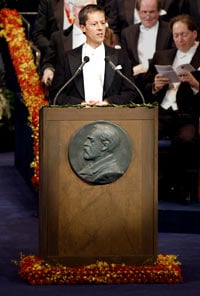Award ceremony speech
Presentation Speech by Professor Gunnar von Heijne of the Royal Swedish Academy of Sciences, December 10, 2003.
Translation of the Swedish text.

Copyright © Nobel Media AB 2003
Photo: Hans Mehlin
Your Majesties, Your Royal Highnesses, Ladies and Gentlemen,
In the days of Alfred Nobel, the learned academies used to entertain and educate the public by holding open demonstrations explaining the latest scientific advances. This tradition has been largely – and perhaps unfortunately – forgotten. So let us try to revive the public demonstration of science, if only for a brief moment.
The demonstration I have in mind is a simple one, and only requires that you do something that is in any case particularly fitting for a Nobel Prize ceremony: to think. But only for exactly 5 seconds!
So, please start thinking, for 5 seconds … Thank you!
Let us now reflect briefly on what has just happened, in each and every one of us. First, a sudden increase in the activity of the brain when you started to wonder what this is all about – should I really think at this point in the ceremony? – then, cascades of nerve signals when you were actually thinking, and finally a return to the normal resting state. And all this thinking ultimately relied on one of the simplest chemical compounds you can imagine: ordinary salt – sodium, potassium and chloride ions – streaming back and forth across the walls of your nerve cells, thereby generating the signals that activated your mind. And not even very much salt – a rough estimate is that the total amount of salt spent during these five seconds in each one of us was no more than a few grains. Only a fistful of salt to set a whole Concert Hall thinking!
And while all this brain activity was occupying our minds, our kidneys worked on quietly, as they always do, reabsorbing water from the urine to the blood. But in this case, the volumes of water transported are too big, even during five seconds, to be suitable for a demonstration from the podium.
This year’s Nobel Prize in Chemistry is all about salt water, and the biochemical mechanisms that control where, when, and how often ions and water are let into or out of the cells in our body. Mechanisms that the two Laureates – Peter Agre and Roderick MacKinnon – have elucidated down to the atomic level.
Agre’s was a “serendipity discovery”: while working on a completely different problem, he stumbled across a protein in red blood cells that he could soon show was the water channel researchers had been looking for in vain for well over a century. His unexpected discovery opened a whole new field of study.
MacKinnon, on the other hand, decided at an early stage that he should try to do what was then thought impossible: to determine the three-dimensional structure of ion channels at atomic resolution. He bet his career on this vision – and succeeded to an extent that probably surprised even himself.
There is a lesson here, I believe: There is no one way to do science, and our support system must be sufficiently well funded and versatile to prepare the ground for both unexpected serendipity and focused, often risky, attacks on central scientific problems.
Peter Agre and Roderick MacKinnon stand for decisive contributions to the biochemistry of cell membranes, but their discoveries also have an almost tangible aesthetic component. Their work has uncovered an amazing “economy of design” in the atomic structures of the water and ion channels that is breathtaking in its simplicity and perfection. Indeed, after seeing these molecular machines, you find yourself thinking, “Of course, this is how it must be, this is how it must work!” What more could we ask of science?
Professor Agre, Professor MacKinnon, your fundamental discoveries concerning water and ion channels are singular achievements that have made it possible for us to see these exquisitely designed molecular machines in action at the atomic level. The biochemical basis for the transport of water – the most abundant and primordial substance of life – and ions – these tiny, mundane and yet absolutely essential constituents of the living world – can now be understood in unparalleled detail. On behalf of the Royal Swedish Academy of Sciences, I wish to convey to you our warmest congratulations, and I now ask you to step forward to receive the Nobel Prize in Chemistry from the hands of His Majesty the King.
Nobel Prizes and laureates
Six prizes were awarded for achievements that have conferred the greatest benefit to humankind. The 12 laureates' work and discoveries range from proteins' structures and machine learning to fighting for a world free of nuclear weapons.
See them all presented here.
